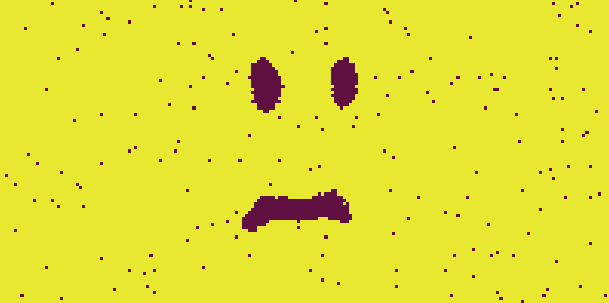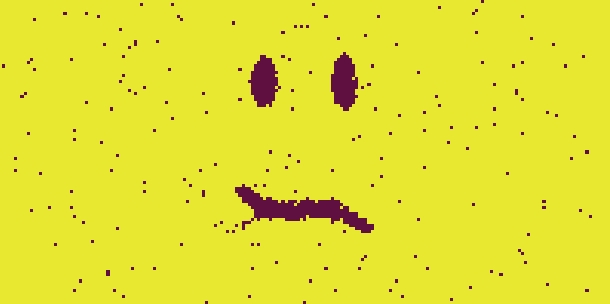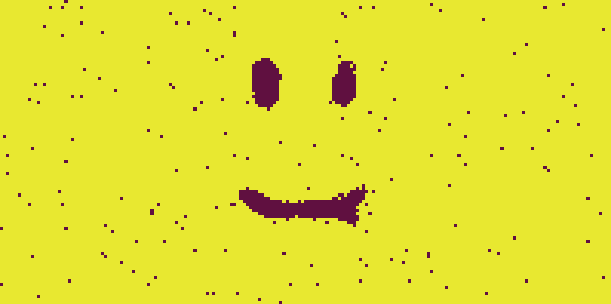Serendip is an independent site partnering with faculty at multiple colleges and universities around the world. Happy exploring!
Deterministic and Non-deterministic Emergence: From Primal Patterns to Emergence
From Primal Patterns to Emergence
Moving beyond primal patterns as a way to make sense of things
"In the beginning was the Word?"
|
Inquiry approach 1
Primal patterns Goal: to characterize the underlying pattern that everything actually relates to Perception of time/evolution: either absent or a parameter along which things get closer to the ideal Status of disorganization: a barrier to detecting the underlying pattern |
One general approach to making sense of the world starts with the presumption that order and patterns are fundamental,and treats disorganization as something secondary: an inherent noisiness in the world that to varying degrees degrades the patterns or imperfections in our perceptual abilities that obscure the patterns, or an indication that some future ideal state of order has yet to be achieved. The task of the inquirer, in all cases, is to try to correct for the source of apparent disorganization so as to discern the underlying fundamental patterns (either Platonic "reality" or "teleological reality", the ideal end state to which everything is moving).
The figure below provides an illustration of a primal pattern approach to making sense of the world. One's impression is of a pattern, "Serendip", that is only vaguely visible because of obscuring disorganization. The impression of "Serendip" can be strengthened by adjusting the two sliders. One's inclination is to move the sliders until the pattern becomes clearest, i.e. to presume the "reality" of a pattern and treat other aspects of what one observes (the disorganization) as obscuring noise that should be reduced as much as possible.
What the image actually consists of is nothing more (and nothing less) than an array of dots each of which is randomly purple or yellow with certain probabilities of being purple or yellow at successive points in time. The probability of being purple for most of the dots is set by one of the sliders. The probability of being purple for a small subset of them is set by the other slider. The images are equally "real" for all slider settings. One's brain looks for small statistical regularities in the behavior of the dots and prefers to enhance them. Other than one's own preference for pattern over disorganization, there is no reason to prefer slider positions that emphasize the pattern over the disorganization that reflects the underlying random character of the dot patterns.
One can, of course, use automated processes to extract "signals" from "noise," but these have always and necessarily been designed to reflect one or another version of a presumption like the one the brain normally makes, that pattern is more significant than randomness. They depend both on an underlying algorithm designed to detect and eliminate "noise" and on some procedure to decide when that has been accomplished. As such they no more detect "reality" than the brain does.
Some of the practical problems associated with automated signal extraction can be illustrated using a simple algorithm, one that enhances by a small amount the probability of a dot being purple when a certain number of its neighbors are also purple and decreases otherwise. In a particular case (click here for model), probabilities of being purple are increased when four or more of the eight total neighbors are purple and decreased otherwise. The "signal" is an array of dots with a slightly higher starting probability of being purple than other dots, as above. While the algorithm always yields a close approximation to the starting signal, it is quite sensitive to the starting condition so that different initial arrays that are more or less random can lead to patterns having quite different significances to an observer (pictured below, click to enlarge).
A more general version of the automated signal extraction algorithm is implemented in the model here. Notice that in many cases, a signal emerges from the noise and then degrades into a less "organized" pattern reflecting the properties of the algorithm more than those of the initial signal. This sort of behavior raises serious questions about the "teleological reality" approach. Is the earlier pattern or the more degraded state the "teleological reality"?
There exist a variety of signal extraction algorithms more sophisticated than those used for these illustrations. In general though they all have the kinds of problems illustrated here and, to deal with them, depend on presumptions (implicit or explicit) about what constitutes noise elimination and how to decide when it has been eliminated.
"Simple things interacting in simple ways can yield surprisingly complex outcomes"
As perceptual abilities were sharpened by technological advances, the emphasis switched from celestial harmonies to newtonian mechanics, which focused on simple things interacting by simple rules. This made it possible to account with greater precision for more observed motions.
Significantly, the newtonian approach itself ultimately proved inadequate to account for many of the details of the masses, orbits, and orbital locations of our particular solar system. To account for these, one needs to move not only beyond the notion of ideal patterns but also that of simple interactions of simple things at a fixed point in time. One needs an additional temporal and historical dimension: the reason for the currently observed distribution of large objects in our solar system is not that it fits a particular spatial pattern in the present. Nor is it that it is moving towards one in the future. Rather it is the current state which has emerged from several billions of years of successive interactions beginning with much smaller and simpler entities, a state that will continue to change.
This illustrates a contrasting general approach to making sense of the world, one that begins not with order and patterns as the explanation but rather as the problem to be accounted for (see From Complexity to Emergence and Beyond (Word file)). Inherent in this approach is both a temporal/historical perspective and the idea that patterns reflect interactions of smaller entities that make them up: a pattern on a larger scale exists not because a particular distribution of smaller entities fits a particular pre-existing template pattern but rather because the pattern itself has been created over time by the interactions of smaller entities. This "emergence" approach was used effectively by Keynes in economics, by Darwin in biology, and has become increasingly important in recent years in a variety of fields of inquiry.
The general emergence approach has the appealing feature of not being dependent on assumptions about primal template patterns, and so avoids the question of what is responsible for the existence of such patterns. At the same time, it doesn't necessarily do away with infinite regress questions (what accounts for the the smaller scale entities and how they interact?). And it leaves open the question of what the relation is between disorganization and pattern. Why do we typically see a world that consists both of patterns and of disorganization? If disorganization is neither a perceptual artifact nor a degradation of pattern, what is it?
| << back |
From Primal Patterns to Emergence
|
next >> |
Posted by Paul Grobstein and Laura Cyckowski 11 Dec 2008.







Comments
Post new comment